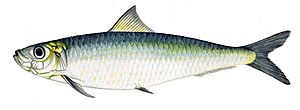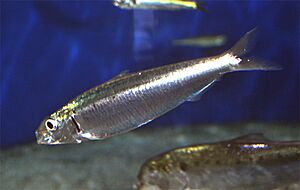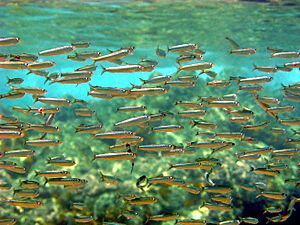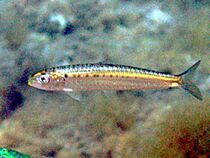European pilchard facts for kids
Quick facts for kids European pilchard |
|
|---|---|
 |
|
 |
|
| Conservation status | |
| Scientific classification | |
| Synonyms | |
|
The European pilchard (Sardina pilchardus) is a type of fish found in the ocean. It belongs to a group of fish called ray-finned fish. Young pilchards are often called sardines. This common fish lives in the northeast Atlantic Ocean, the Mediterranean Sea, and the Black Sea. You can find them at depths from about 30 to 330 feet (10 to 100 meters).
European pilchards can grow up to about 11 inches (27.5 cm) long. They mostly eat tiny sea creatures called plankton. These fish swim together in large groups, called schools. Each female pilchard can lay many eggs, usually between 50,000 and 60,000!
Contents
What Does a Pilchard Look Like?
The European pilchard is a small to medium-sized fish. It looks a bit like a herring and has a slightly long body. Its fins near the belly (pelvic fins) are located behind its back fin (dorsal fin). The last two soft rays on its bottom fin (anal fin) are bigger than the others.
The top of the pilchard's body is green or olive colored. Its sides are golden, and its belly is shiny silver.
Where Do Pilchards Live?
The European pilchard lives in the northeastern Atlantic Ocean, the Mediterranean Sea, and the Black Sea. You can find them from Iceland and southern Norway all the way down to Senegal in West Africa. In the Mediterranean Sea, they are common in the western part and the Adriatic Sea. However, they are less common in the eastern Mediterranean and the Black Sea.
These fish often travel and swim in large schools. They usually stay near the coast but can sometimes go as far as 60 miles (100 km) out to sea. During the day, they are mostly found about 80 to 180 feet (25 to 55 meters) deep. But they can dive even deeper, up to 330 feet (100 meters). At night, they usually swim closer to the surface, about 30 to 115 feet (10 to 35 meters) deep.
Pilchard Life and Diet

In the Mediterranean Sea, European pilchards move away from the coast in the autumn. They prefer the deeper, cooler waters of the open sea. This is because the temperature and saltiness of coastal waters can change a lot.
Reproduction and Growth
Pilchards start laying eggs in winter. In early spring, young pilchards (juveniles), tiny larvae, and some adult fish move closer to the coast. Other adults migrate to the coast later in the year. Female pilchards lay many batches of eggs over a long breeding season. Each female can lay between 50,000 and 60,000 eggs in total.
Most young pilchards can start having babies when they are about one year old. At this age, they are usually about 5 to 5.5 inches (13 to 14 cm) long. Pilchards are fully grown when they are about 8 years old and around 8 inches (21 cm) long.
What Pilchards Eat
European pilchards eat both zooplankton (tiny animals) and phytoplankton (tiny plants). The zooplankton they eat are mostly small crustaceans called copepods and their young. These copepods swim up to the surface at night to feed. This is when adult pilchards eat them. Young pilchards, however, feed during the day as well.
Pilchards are an important part of the ocean's food chain. Along with the European anchovy, they eat plankton. Then, larger fish like the European hake and the European conger eel eat the pilchards. This is especially true in the Adriatic Sea. If too many pilchards and anchovies are caught, it can cause big changes in the ocean's ecosystem.
Fishing for Pilchards
People fish for European pilchards in most areas where they live. Fishermen mainly catch them using large nets called purse seines and lampara nets. Other methods, like bottom trawling, are also used.
Around one million tons of pilchards are caught each year. Morocco, Portugal, and Spain catch the most. The Food and Agriculture Organization (FAO) believes that too many pilchards are being caught in Morocco.
Pilchards and Sardines
Adult pilchards are sold as "pilchards," while younger ones are sold as "sardines." The names "sardine" and "pilchard" can be a bit confusing. What they mean depends on where you are. For example, in the United Kingdom, "sardines" are considered young pilchards. Some people say fish shorter than 6 inches (15 cm) are sardines, and larger fish are pilchards. The FAO and WHO say that 21 different types of fish can be called sardines when they are canned.
Pilchards are sold fresh, frozen, or canned. They can also be salted, smoked, or dried. Since their meat is not very expensive, some of the fish caught are used as fishing bait or fertilizer. Some are also turned into fish meal, which is used to feed other animals.
See also
 In Spanish: Sardina común para niños
In Spanish: Sardina común para niños



